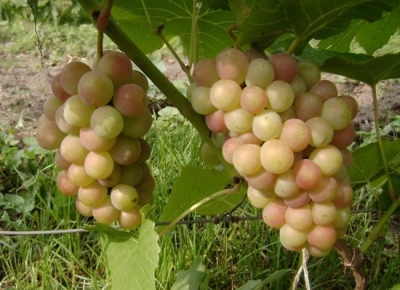
- Authors: Lithuania
- Appointment: universal
- Berry color: pink
- Taste: isable
- Frost resistance, ° C: -30
- Bunch weight, g: 300-350
- Flower type: bisexual
- Density of the bunch: dense
- Skin: dense, edible
- Appeared when crossing: interspecific hybrid featuring Vitis Labrusca
There are a lot of grape varieties. However, even with this variety, the Palanga variety has impressive advantages. It is necessary to deal with all its features.
Breeding history
Palanga grapes were developed by Lithuanian breeders. To obtain it, different types of planting material were used. Among them Vytis Labruska stands out. The selection was aimed at obtaining a versatile plant. Despite the Baltic origin, the variety is acceptable for the vast majority of viticultural regions.
Geography of distribution
The plant is great for relatively cold areas. Excellent cultivation is guaranteed in the vicinity of Moscow. Cultivation is also permissible in the south of Siberia. In these regions Palanga can be grown without special shelters. However, precautions are sometimes necessary.
Description
Ripening period
The plant belongs to the early group. It bears fruit in 115-120 days after planting. In the Novocherkassk region, the harvest will have to wait until early August. The bushes form many powerful shoots. Problems sometimes arise in the middle lane.
Bunches
Palanga brushes represent a cross between a cylinder and a cone. Fruits in clusters are grouped tightly. Their mass ranges from 300 to 350 g. Therefore, it is hardly necessary to talk about record harvests.
Berries
Palanga grapes are rounded. They are pink in color. The mass of one fruit is approximately equal to 3 g. Cracking of grapes is not typical of this variety. The skin is relatively firm.
Taste
According to the tasters, Palanga leaves an isable sensation. The sugar concentration is from 220 to 230 g per 1 dm3. The same volume contains 5-7 g of acid. The pulp is juicy and leaves a slimy impression. The peel can be eaten.
Yield
The proportion of fruiting shoots ranges from 70 to 75%. There are 1.4 to 1.7 bunches per shoot. Each bush develops 30-40 eyes. In terms of yield, this variety is at an average level. But not the highest fertility is justified by other valuable properties.


Growing features
Landing
There are no reliable special recommendations specifically for planting this variety. However, you can be guided by quite general advice for the cultivation of early grapes. Landing in low-lying areas should be avoided whenever possible. The use of drugs that activate rooting is useful. The scheme of planting bushes is traditional.

Pollination
Bisexual flowers greatly simplify matters. Under normal growing conditions, increased pollination is not required. Artificial procedures are needed only in bad weather.
Pruning
The vigorous growth of grapes makes pruning a very urgent step. The procedure is carried out every autumn. Vine shaping improves the development of shrubs. It also becomes a condition for the full formation of the crop. In addition to pruning, shoots need to be tied up.

Watering
Wet soil is quite relevant for Palanga. But at the same time, excessive moisture is impractical and even harmful. Both the condition of the soil and the weather forecast are taken into account. After each watering, it is required to thoroughly loosen the soil. Experts advise to combine irrigation and application of nutrients in one procedure.


Top dressing
The first laying of nutrients is carried out in the spring. At the same time, they are guided by reaching a stable temperature of +16 degrees. For 10 liters of water, dilute:
20 g superphosphate;
5 g of potassium salt;
10 g of ammonium nitrate.
The second feeding is carried out with the help of potassium and phosphorus. Their ratio will be 1 to 2. It is necessary to introduce the mixture during the formation of ovaries. When the berries begin to actively ripen, you will need to use a solution of potassium sulfate and superphosphate. Such a solution is poured under the root.
Frost resistance and the need for shelter
Palanga retains its qualities at temperatures down to –30 degrees. There is no need for shelter in most of the Russian territory. Even in the south of Siberia, it is almost always possible to successfully grow it in an open culture. Only with various experiments on growing this plant in the north will it be necessary to engage in covering work. Moisture-charging irrigation still does not hurt.

Diseases and pests
The resistance of this variety is very high in relation to:
mildew;
gray rot;
oidium.
Wasps sometimes attack crops. Pouches help block their invasion. Spicy herbs are planted nearby to distract the winged sweets. Prevention is carried out by applying Bordeaux liquid and ferrous sulfate. And also recommend to use "Ridomil" and "Tsineb".

If a grape is exposed to any disease or insect, this always affects its appearance.
Storage
Palanga does not try to keep grapes for a long time. It is mainly used fresh. And also often the fruits are processed into wine.Due to the sugar content, long-term preservation of the berries is hardly possible. They are distinguished by an average level of transportability.











































































